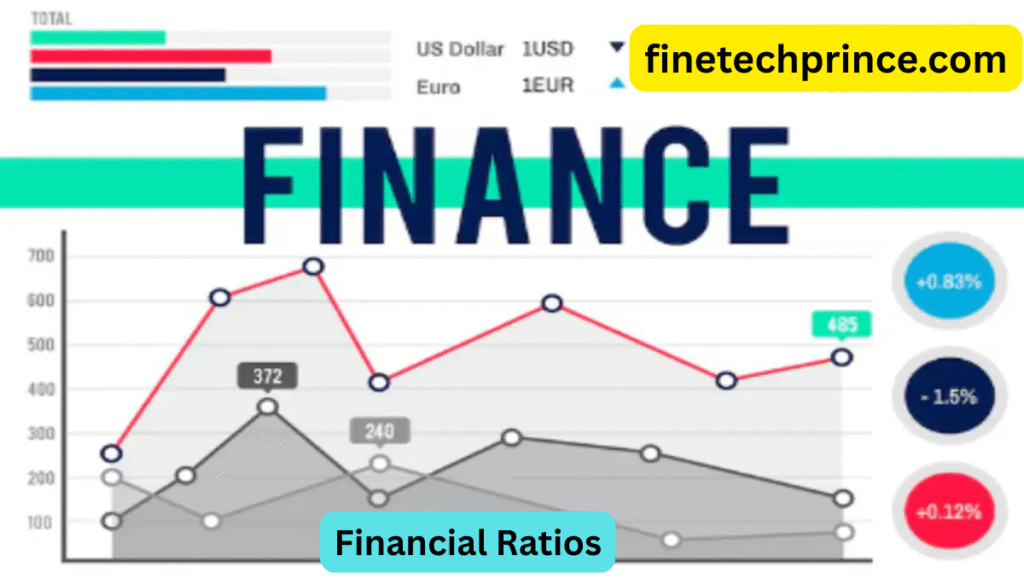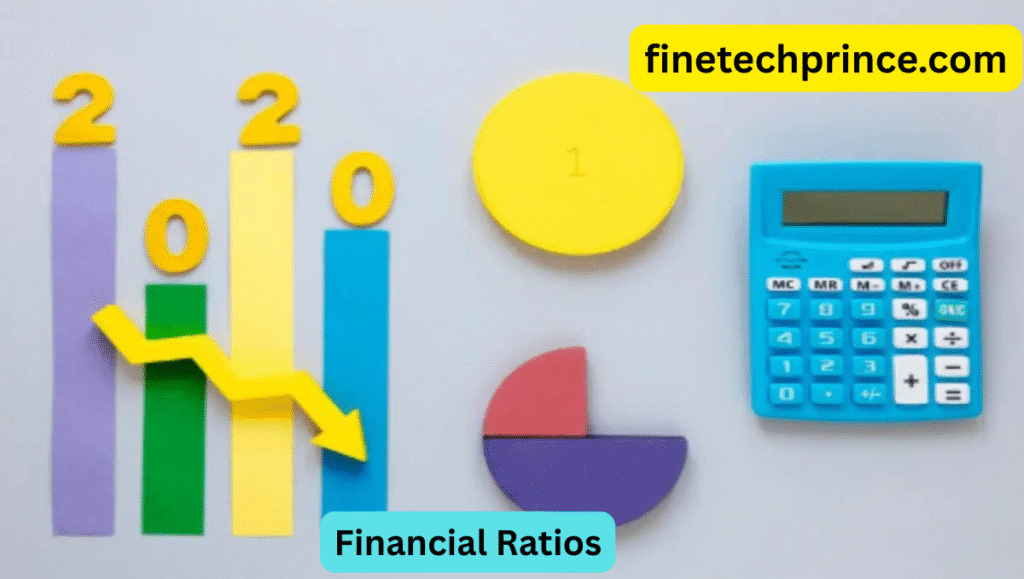welcome to my new blog post…
Financial ratios are useful instruments in the world of finance and investing for assessing a company’s overall health and performance. Knowing how to analyse these ratios, whether you’re a financial analyst, investor, or entrepreneur, may provide you the information you need to make wise financial decisions. This blog article will look at the relevance of financial-ratios, their many varieties, and how they may be used to assess a company’s financial status.
What Are Financial Ratios?
A financial ratio is a comparison of two or more financial variables from a company’s financial statements. These statistics assist stakeholders, including investors, creditors, analysts, and management, in understanding the company’s financial performance and health. Financial ratios can reflect patterns in profitability, liquidity, solvency, and efficiency, providing an indication of a company’s capacity to efficiently manage its operations and finances.

Why are financial ratios important?
Measuring performance Financial-ratios provide a thorough examination of a company’s financial performance over time. Businesses may monitor their growth, profitability, and general financial health by comparing ratios from year to year.
Investors utilize financial statistics to discover good, long-term investment opportunities. Return on equity (ROE) and earnings per share (EPS) ratios can provide insight into a company’s profitability and growth prospects.
Benchmarking: Financial ratios enable organisations compare their performance to industry norms or rivals. This can aid in determining areas where the organisation may be failing or flourishing.
Creditworthiness Evaluation: Financial ratios are frequently used by lenders and creditors to decide whether to give credit to a firm. Lenders can analyse the risk of lending to a firm using ratios such as the current ratio or the debt-to-equity ratio.

Different types of financial ratios
Financial-ratios are roughly classified into five categories: liquidity ratios, profitability ratios, leverage ratios, efficiency ratios, and market ratios. Each of these areas sheds light on distinct facets of a company’s financial performance.
Liquidity Ratio
Liquidity ratios assess a company’s capacity to satisfy short-term obligations using its most liquid assets. These measures are critical in evaluating a company’s short-term financial health.
Current ratio: This is among the most commonly used liquidity ratios. The calculation is as follows:
Current Ratio equals Current AssetsCurrent ratio = \frac{\text{Current Assets}}{\text{Current Liabilities}}Current ratio equals current liabilities.Current AssetsA ratio of 1 or higher indicates a company’s ability to cover short-term obligations.
The quick ratio (also known as the acid-test ratio) The fast ratio is a more strict liquidity test that separates inventories from current assets. The calculation is as follows:
Quick Ratio = Current Assets minus Inventory.The quick ratio for current liabilities is \frac{\text{Current Assets} – \text{Inventory}}{\text{Current Liabilities}}.Quick Ratio=current liabilities.Inventory – Current AssetsA fast ratio of 1 or greater demonstrates a company’s ability to satisfy short-term obligations despite a drop in sales or inventory turnover.
Profitability Ratios
Profitability ratios evaluate a company’s capacity to create earnings in comparison to its sales, assets, or equity. These measures are critical for investors seeking lucrative firms.
Gross Profit Margin: This ratio indicates how much of each dollar of revenue remains after deducting the cost of goods sold (COGS). The formula for calculating gross profit margin is \frac{\text{Revenue} – \text{COGS}}{\text{Revenue}} �times 100.Gross Profit Margin = Revenue – COGS x 100.
A larger margin reflects a company’s strong capacity to profit from its sales.
Nett Profit Margin: This ratio indicates the proportion of revenue that remains as profit after all expenditures are deducted. The formula for calculating net profit margin is \frac{\text{Net Income}}{\text{Revenue}} multiplied by 100.Nett profit margin is calculated by multiplying revenue and net income by 100.
A larger net profit margin shows effective management and profitability.
Return on Equity (ROE): This ratio assesses a company’s capacity to profit from its shareholder equity. ROE is measured as Nett Income.Shareholders’ Equity: 100ROE = \frac{\text{Net Income}}{\text{Shareholders’ Equity}} \times 100.ROE = Shareholders’ Equity/Net Income multiplied by 100
A greater ROE indicates that the firm is successfully allocating its equity to create profits.

Leverage ratios
Leverage ratios assess a company’s capacity to satisfy long-term financial obligations and its reliance on debt to fund operations.
Debt/Equity Ratio: This ratio indicates the proportion of debt employed in comparison to equity financing. The calculation is as follows:
Debt-to-equity ratio equals total debt.The debt-to-equity ratio is calculated as \frac{\text{Total Debt}}{\text{Shareholders’ Equity}}.Debt-to-Equity Ratio = Shareholders’ EquityTotal debtA larger ratio shows financial leverage, which can be problematic if the firm cannot satisfy debt commitments.
The Interest Coverage Ratio assesses a company’s capacity to pay interest on debt. The calculation is as follows:
The interest coverage ratio is calculated as \frac{\text{EBIT}}{\text{Interest Expense}}.Interest Coverage Ratio equals interest expense.EBITA greater ratio reflects the company’s ability to cover interest payments.
Efficiency Ratios: Evaluate a company’s ability to create sales and profits through asset utilisation.
Inventory Turnover: This ratio tracks how many times a company’s inventory is sold and replaced in a given period. The calculation is as follows:
Inventory turnover is equal to the ratio of COGS to average inventory. Inventory turnover equals the average inventory COGS.A high turnover ratio suggests effective inventory management.
Related Articles
Receivables Turnover: This ratio measures how successfully a firm handles its receivables. The calculation is as follows:
Receivables Turnover = Nett Credit Sales/Average Accounts Receivable Receivables turnover equals Average Accounts. Receivable Nett Credit SalesA greater percentage indicates that the firm is effective in collecting money.

Market ratios.
Market ratios show a company’s market worth in relation to its financial performance.
The price-to-earnings (P/E) ratio This ratio reflects how much investors are prepared to pay every dollar of profits. The calculation is as follows:
P/E Ratio = Market Price per Share Earnings per Share (EPS)The P/E ratio is defined as \frac{\text{Market Price per Share}}{\text{Earnings per Share (EPS)}}.P/E Ratio = Earnings Per Share (EPS).Market price per share.A high P/E ratio indicates strong investor expectations for future growth, while a low ratio may imply undervaluation.
Dividend Yield: This ratio calculates the return on investment from dividends. The calculation is as follows:
Dividend Yield is calculated by multiplying annual dividends per share by market price per share. Dividend Yield = \frac{\text{Annual Dividends per Share}}{\text{Market Price per Share}} times 100Dividend Yield = Market Price per Share/Annual Dividends per Share multiplied by 100.
A high dividend yield might attract income-seeking investors.
Conclusion
Financial ratios are crucial instruments for assessing a company’s financial health. By analysing liquidity, profitability, leverage, efficiency, and market ratios, stakeholders can acquire significant insights into a company’s performance and identify possible hazards or opportunities. Understanding and applying these ratios can allow you to make more educated decisions, whether you are an investor, lender, or management. The key to financial success is not simply looking at one ratio, but knowing how different ratios function together to give a whole picture of a company’s financial situation.
Here are 7 quick questions on financial ratios:
1. What is a financial ratio?
Financial ratios are measurements that evaluate a company’s financial health by comparing various financial statistics from its financial statements.
2. Why are financial ratios important?
They assist investors, creditors, and management in assessing a company’s performance, profitability, liquidity, and solvency.
3.What is the current ratio?
The current ratio is a liquidity metric that compares a company’s current assets to current liabilities to determine its capacity to satisfy short-term obligations.
4. What is the company’s return on equity (ROE)?
ROE assesses a company’s profitability by comparing nett income to shareholders’ equity, demonstrating how effectively it uses investors’ capital.
5. What does a high debt-to-equity ratio imply?
A high debt-to-equity ratio implies that a firm relies substantially on debt funding, which can be problematic if the company is unable to repay obligations.
6. How does the price-to-earnings (P/E) ratio work?
The P/E ratio compares a company’s market price per share to its profits per share, which helps investors determine stock valuation and growth potential.
7. What is the Quick Ratio?
The fast ratio is a more strict liquidity metric that excludes inventory from current assets to assess a company’s capacity to satisfy short-term obligations without selling inventory.

2 thoughts on “Popular Financial Ratios: Evaluating Business in 2025”